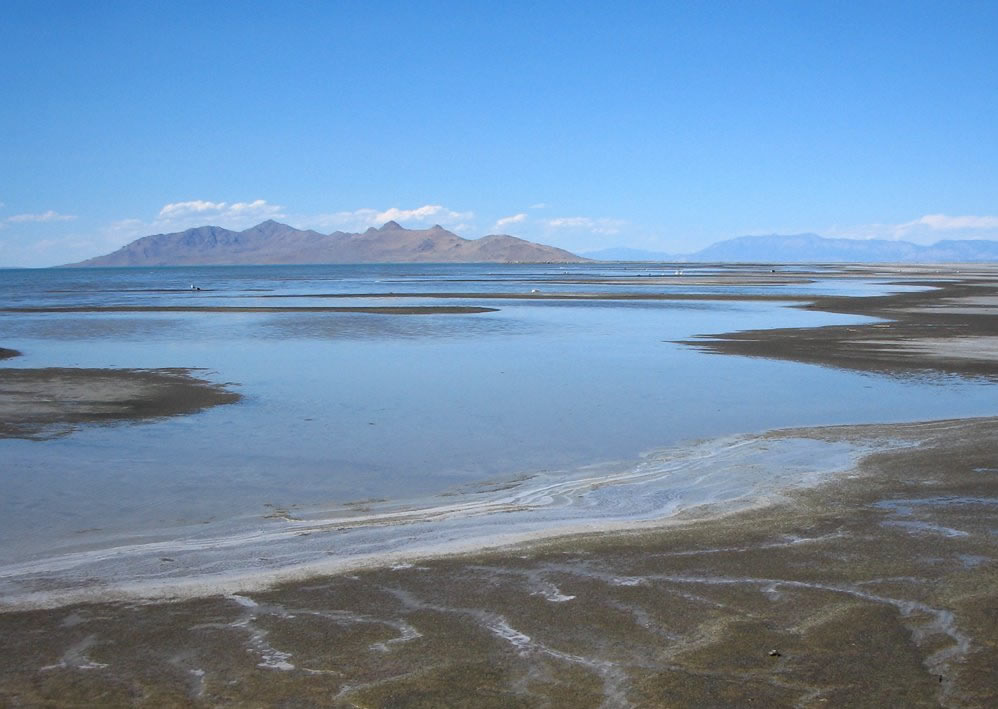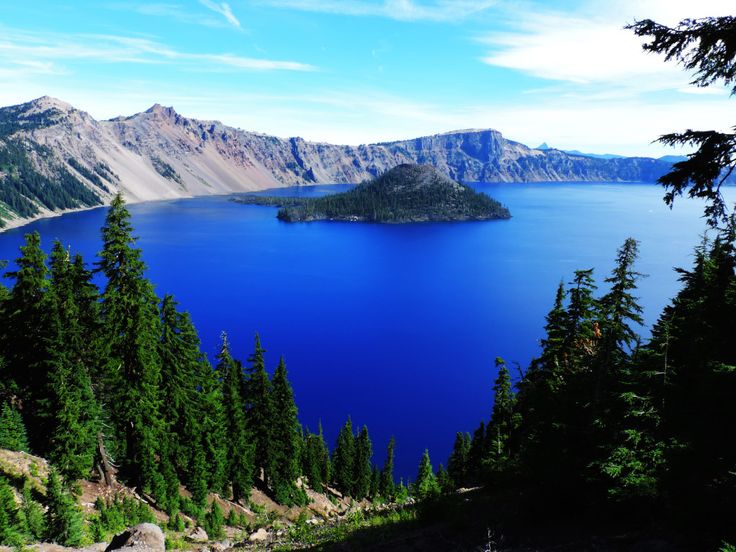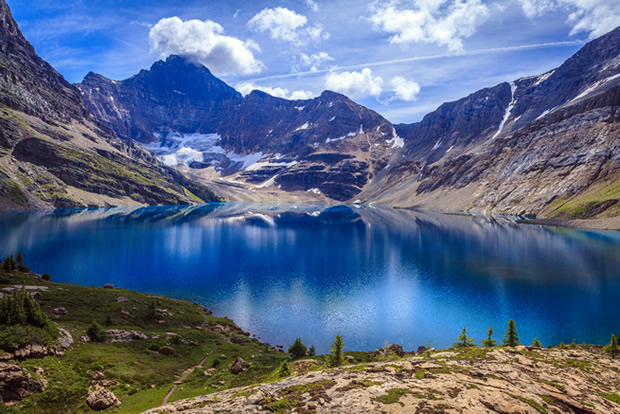 |
| Lake |
Lakes are large inland bodies of fresh or saline (salty) water. Lakes form in places where water collects in low areas or behind natural or man-made dams (barriers constructed to contain the flow of water).
Some lakes are fed by streams (natural bodies of flowing freshwater), and some form where groundwater (water flowing in rock layers beneath the land surface) discharges onto the land surface.
Water leaves lakes by flowing into outlet streams, infiltrating (soaking in) into groundwater reservoirs called aquifers, and by evaporating into the atmosphere (mass of air surrounding Earth). Lakes vary in size from large lakes such as the Great Lakes of North America, to small mountain lakes.
  |
Lakes are larger than ponds, which are small bodies of fresh water that are shallow enough for rooted plants to grow. The study of ecology (relationships between living organisms and their environment) in lakes, inland seas, and wetlands is called limnology.
Lakes store only a tiny percentage of Earth’s fresh water. They are, however, an extremely important water resource for humans. Freshwater lakes provide water for agricultural irrigation (watering), industrial processes, municipal uses, and residential water supplies.
People who live in the continental interiors use lakes for fishing and recreation, and very large lakes have important shipping and transportation routes. Humans also construct artificial lakes, called reservoirs, by building dams across rivers.
In addition to providing the benefits of natural lakes, reservoirs also store water for specific communities, control floods, and generate hydroelectricity (electricity generated from water power).
How lakes form and disappear
Earth scientists who study water on the continents (hydrologists and hydrogeologists) see lakes as temporary reservoirs within stream and groundwater systems.
All water that falls as precipitation (rain, snow, sleet, hail) on the land surface of continents eventually makes its way to the ocean or evaporates back into the atmosphere.
Water collects in lakes because it enters more rapidly than it escapes, but it is never permanently trapped there. As in a tub with a running faucet and an open drain, individual water molecules (smallest unit of water, each containing two hydrogen atoms and one oxygen atom) are constantly entering and escaping.
After arriving in a lake, an average water molecule spends about one hundred years before moving to a new reservoir. (The time that an average water molecule spends in a reservoir is called it residence time.
Water resides for about two weeks in rivers, forty years in glaciers (slow moving mass of ice), and between two hundred and ten thousand years in groundwater reservoirs.)
To geologists (Earth scientists), lakes are temporary features. Stream-fed lakes within stream systems are destined for destruction. Every stream seeks to create a constant slope, called a graded profile, between where the stream’s waters begin and ends by eroding (wearing away) and depositing sediment (particles of sand, silt, and clay) along its course.
When a natural or man-made obstruction blocks a stream, such as a river, streams deposit sediment in the lake or reservoir behind the obstruction and erode away in front of it.
Eventually, the dam will collapse, and the lake will empty. Lakes that fill depressions and have no outlets fill when the regional climate becomes wetter or when warm periods melt mountain snows and glacial ice.
They evaporate away during periods of dry weather and dryer climate. It may take thousands, or even tens of thousands of years, but lakes eventually drain, collapse, or dry up.
Lake layers and overturns
Contrary to their common image as evenly mixed pools of unmoving water, lakes are complex, dynamic bodies of moving surface water. Lake water varies within the lake; its temperature, chemical content, light infiltration, and biological habitats vary from top to bottom and side to side.
Furthermore, the vertical layering (stratification), horizontal variations, and circulation patterns within lakes change over time. Waves, currents (a moving mass of water), and even tides affect circulation of water within lakes.
Lakes are thermally stratified (layered according to temperature); they have layers of warm and cool water that are separated by layers where the temperature changes (thermoclines). Like the oceans, many lakes have a thin layer of warm surface water, and a thicker layer of cool deep water that is separated by a thermocline layer.
Wind generates currents on lake surfaces and creates some mixing. Unlike the oceans, however, many lakes have seasonal overturns that mix their waters. water is denser than solid water (ice). Water reaches its maximum density at 39°F (4°C).
Because of this odd property, the warm less-dense water rises, the cool denser water sinks, ice floats, and lakes overturn. Lakes that are ice-covered for part of the year undergo overturns that partially or completely mix their waters.
Many lakes in temperate (moderate temperatures) regions like the northern United States overturn and mix completely twice a year (dimictic lakes). During the warm summer months, these lakes have a usual temperature profile with warm surface waters, a thermocline, and cool bottom water.
In the fall, when the surface water cools down to 39°F (4°C), it becomes denser than the water underneath it and the surface layer sinks to the bottom. The bottom water rises to the surface, and the lake overturns.
Over the winter, the bottom water is the warmest, and the frozen surface water is the coldest. (Plants and animals survive the winter on the lake floor in the chilly, but not frozen, bottom water.) In the spring, when the ice melts, and the water warms to 39°F (4°C), it sinks, and the lake overturns again.
Limnologists classify lakes according to the number of mixing events they undergo each year. Lake type classifications have the root term mictic, meaning “to mix,” and include:
- Oligomictic: Warm, ice-free lakes that rarely mix. They are warmest at the top, and coolest at the bottom. Tropical, oligomictic lakes have warm bottom water and very warm surface water. They rarely overturn because their water does not near 39°F (4°C).
- Meromictic: Warm, ice-free lakes that mix incompletely. These are deep lakes that are warmest at the top, and coolest at the bottom.
- Monomictic/dimictic/polymictic: Lakes with seasonal ice covers that overturn and mix completely once (monomictic), twice (dimictic), or many times per year (polymictic). Lake overturns are the norm in temperate regions, but local conditions affect the timing and number of overturns in specific lakes.
- Amictic: Lakes that never overturn because they are ice-covered throughout the year. These lakes exist near the North and South Poles and atop very high mountains. They have cold bottom water that hovers near 39°F (4°C) and frozen surface water.
Lake chemistry: saline lakes
Many of Earth’s largest and most important lakes contain salt water. All surface water contains some dissolved chemicals, called salts. Groundwater, streams, and freshwater lakes all contain the chemical components of rocks and minerals. Humans can drink fresh water because our bodies can use or at least tolerate the types and concentrations of dissolved chemicals it contains.
Salt water, on the other hand, has a very high concentration of dissolved salts, and is undrinkable. The Dead Sea, on the border between Israel and Jordan, is Earth’s saltiest body of water. It is truly a dead sea because it is too salty to support life.
Saline lakes generally form in arid (dry) regions where surface water evaporates quickly. When water evaporates, the salts stay behind. Over time, the lake water becomes saltier.
 |
| Great Salt Lake |
Some saline lakes, such as the Great Salt Lake, are all that remains of a much larger fresh water lake that has evaporated over time. Others, like the Caspian Sea in central Asia, began as saltwater filled ocean basins that have since closed.
Saline lakes are often temporary features that fill during periods of wetter climate and then dry up when stream flow or groundwater discharge slows. Playa lakes are flat desert basins that occasionally fill with water. Desert oases (watering holes) form and disappear with such regularity that thirsty travelers think they imagined them.
The Great Salt Lake, Caspian Sea, Aral Sea, and Dead Sea are all presently evaporating. Over time, the dissolved chemicals become so concentrated in drying lakes that they bond together and form solid salt crystals. Thick layers of salt cover dry lake beds.
Lake biology
Lakes support rich communities of plants and animals (ecosystems) that have adapted to live within ever-changing conditions on lake beds, within the water column (water running from the surface to the lake floor, often showing differences in temperature, nutrients, etc.), and along lake shores.
Lakes, like islands, are often closed systems that only rarely gain new species or individuals from other lakes. Many lakes host groups of rare species that have evolved (changed over time) together in their specific lake.
These ecosystems are rich and unique, but fragile. They have little defense against foreign predators or diseases. Human alterations and water pollution have threatened many lake species.
Environmental groups and government agencies are presently attempting to protect and revive threatened lake species such as cichlids (rare doublejawed fish) that inhabit the lakes of the Great Rift Valley in east Africa.
Lake organisms live in zones that are determined by the physical structure of their lakes such as the amount of available light, water depth, and distribution of nutrients. Most lake plants and animals live in shallow, well-lit surface waters called the euphotic zone.
Most plants depend on the Sun’s energy to produce food by the chemical process of photosynthesis, and they cannot grow in water that is too deep or too cloudy for light to penetrate. Lake animals such as fish need oxygen that plants give off during photosynthesis, so they live mostly in the euphotic zone as well.
Plants with roots grow in shallow water along edges of lakes where light reaches the lake floor (littoral zone) and floating plants perform photosynthesis in the open surface waters (limnetic zone). Oxygen-consuming bacteria inhabit the deepest, darkest parts of lakes (benthic zone) where dead plant and animal materials accumulate.
Limnologists also classify lakes by the balance of organisms and nutrients in their waters. Types include lakes that are described as oligotrophic, eutrophic, and mesotrophic.
- Oligotrophic: Nutrient poor lakes that support very few plants and animals. Oligotrophic lakes are typically cool, deep, and have very clear water. Very little organic (relating to or from living organisms) mud accumulates in oligotropic lakes, and they often have sand and gravel beds.
- Eutrophic: Lakes rich in plant nutrients that support abundant plant life in their surface waters. Their water is often clouded by microscopic plants, and their beds covered with thick layers of decaying plant material. Bacteria that live on the organic mud use up oxygen, and eutrophic lakes often have oxygen-poor deep water. Plants and bacteria eventually take over eutrophic lakes. They become oxygen-poor bogs and marshes where fish cannot live. Some chemicals that humans use, including fertilizers and detergents, cause a process called eutrophication when they run off into lakes, which causes the population of plants to increase to such an extent that eventually oxygen-starved fish die.
- Mesotrophic: Lakes with moderate amounts of nutrients and healthy, balanced communities of plants, animals and bacteria. Mesotrophic lakes receive adequate amounts of fresh water and nutrients, and seasonal overturns allow nutrient-poor and nutrient-rich layers to mix. Mesotrophic lakes are intermediate between crystal-clear, lifeless oligothrophic lakes and cloudy, muddy eutrophic lakes.
Where lakes form: lake basins
Lakes form where water collects in depressions, or basins. Many lakes fill low areas created by plate tectonic movements (tectonic basins) and volcanic activity. (Plate tectonics is the movement of large, rigid pieces of Earth’s outer rock shell called the lithosphere.)
Retreating glaciers and ice sheets leave behind large basins and small depressions that fill with melt water. Though flowing streams and rivers generally act to fill in and drain lake basins, other sedimentary processes can create landscape depressions and natural dams that confine water in lakes.
Lakes in tectonic basins
Rift valley lakes fill long, linear valleys within rift zones. (Rifts are areas where the continental lithosphere is stretching and beginning to break into pieces.
They are the precursors of ocean basins.) A chain of large lakes including Tanganyika, Naiveté, and Malawi follows the Great Rift Valley through eastern Africa. Lake Victoria, the world’s second-largest lake, lies between two branches of the rift valley.
The Red Sea, Sea of Galilee, Dead Sea, and Gulf of Ababa fill the northern branches of the rift where it crosses the Arabian Peninsula in the Middle East. Russia’s Lake Baikal, the world’s deepest lake, fills an ancient, inactive rift valley in central Asia.
Lakes also form in places where continents are moving toward each other. The Black Sea, Caspian Sea, and Mediterranean Seas fill a closing ocean basin between Africa and Europe.
When continents collide, water fills depressions in the landscape over folded and broken (faulted) rock layers that were caught between the land masses. Slopes that are too steep collapse and block rivers with natural dams. Blocks of uplifted, erosion-resistant rock form bedrock that holds back mountain lakes.
Volcanic lakes
 |
| Volcanic lakes |
Volcanoes are mountains that form from eruptions of molten rock (lava) on the land surface. When a volcanic peak collapses into its emptied magma chamber (a pool or room of magna held under tremendous pressure within a volcano prior to a volcanic eruption), it forms a large circular basin called a caldera. (Craters, the small basins near the top of active volcanoes, sometimes also contain small lakes, but most significant volcanic lakes, including inaccurately-named Crater Lake, fill calderas.)
Yellowstone Lake in Wyoming and Crater Lake in Oregon are examples of caldera lakes. Volcanic ash, mud, and lava flows also create natural dams in river valleys. A dam of volcanic rock confines Lake Tahoe in a high valley of the Sierra Mountains on the California-Nevada border.
Glacial lakes
The thick continental ice sheets that covered northern North America, Europe, and Asia during the Pleistocene ice ages (a division of geologic time that lasted from two million to ten thousand years ago) left behind thousands of lake and ponds when they retreated about twenty thousand years ago.
 |
| Glacial lake |
The weight of the ice sheets pushed down on the continents, leaving broad basins that filled with melt water when they retreated. The Great Lakes of North America (Superior, Huron, Michigan, Erie, and Ontario) formed this way.
Hundreds of lakes, such as the Winnipeg, Athabasca, Great Slave, and Great Bear cover the central and eastern provinces and territories of Canada that are still rebounding from their heavy ice load.
Advancing glaciers also pile tall ridges of sediment, called moraines, at their toes (the end of extensions of glaciers along the ground). When glaciers retreat, moraines hold back meltwater.
Small lakes and ponds also form in glacial depressions called kettles that form when blocks of ice buried in glacial sediment melt. Melting mountain glaciers feed many mountain lakes and glacial sediment traps streams and meltwater.
Groundwater discharge lakes
Water moving through pore spaces in rock and soil layers discharges on the land surface in places where the water table (level below which pore spaces are saturated with water) intersects the land surface.
In regions with wet climates, the water table is near the land surface and ground water discharges in low spots. Groundwater chemically erodes limestone and other rocks and creates caves, cavities, sink holes, and collapse basins called karst features. Florida’s many lakes, including Lake Okeechobee, are groundwater-filled karst features.